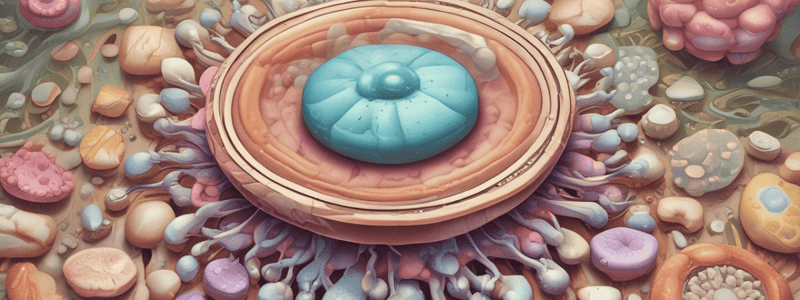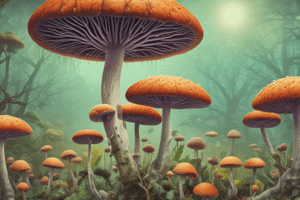Podcast
Questions and Answers
What is the primary mechanism of action of echinocandin antifungal drugs?
What is the primary mechanism of action of echinocandin antifungal drugs?
- Inhibition of beta-1,3-glucan synthase (correct)
- Inhibition of squalene epoxidase
- Inhibition of lanosterol 14-alpha-demethylase
- Inhibition of fungal cell membrane ergosterol synthesis
Which type of fungal infection is characterized by infections of nails, skin, and mucous membranes caused by dermatophytes and yeasts?
Which type of fungal infection is characterized by infections of nails, skin, and mucous membranes caused by dermatophytes and yeasts?
- Superficial mycoses (correct)
- Subcutaneous mycoses
- Systemic mycoses
- Cutaneous mycoses
What is the term for dermatophyte infection of the nails?
What is the term for dermatophyte infection of the nails?
- Onychomycosis (correct)
- Tinea corporis
- Tinea cruris
- Tinea pedis
Which of the following is NOT a type of superficial yeast infection?
Which of the following is NOT a type of superficial yeast infection?
What is the name of the azole antifungal drug commonly used to treat fungal infections such as athlete's foot and ringworm?
What is the name of the azole antifungal drug commonly used to treat fungal infections such as athlete's foot and ringworm?
Which type of fungal infection is characterized by soft tissue infections, UTIs, pneumonia, and meningitis?
Which type of fungal infection is characterized by soft tissue infections, UTIs, pneumonia, and meningitis?
What is the term for fungal infection of the body characterized by an annular, scaly rash with a clear center?
What is the term for fungal infection of the body characterized by an annular, scaly rash with a clear center?
Which of the following is an example of a subcutaneous mycosis?
Which of the following is an example of a subcutaneous mycosis?
What is the name of the polyene antifungal drug commonly used to treat systemic fungal infections?
What is the name of the polyene antifungal drug commonly used to treat systemic fungal infections?
Which of the following fungal infections is characterized by a rash with pruritus and erythema?
Which of the following fungal infections is characterized by a rash with pruritus and erythema?
Which fungal infection is caused by blastomyces dermatitidis and endemic to North America?
Which fungal infection is caused by blastomyces dermatitidis and endemic to North America?
What is the classic triad of symptoms seen in coccidioidomycosis?
What is the classic triad of symptoms seen in coccidioidomycosis?
Which of the following fungi is NOT a cause of subcutaneous mycoses?
Which of the following fungi is NOT a cause of subcutaneous mycoses?
What is the name of the fungal infection caused by coccidioides immitis or coccidioides posadasii?
What is the name of the fungal infection caused by coccidioides immitis or coccidioides posadasii?
Which of the following fungi causes tinea versicolor?
Which of the following fungi causes tinea versicolor?
What is the name of the fungal infection caused by blastomyces dermatitidis?
What is the name of the fungal infection caused by blastomyces dermatitidis?
Which of the following is an example of an invasive and life-threatening systemic mycosis?
Which of the following is an example of an invasive and life-threatening systemic mycosis?
What is the name of the fungal disease that causes skin lesions, bony lytic lesions, and flu-like symptoms?
What is the name of the fungal disease that causes skin lesions, bony lytic lesions, and flu-like symptoms?
Which of the following is NOT a systemic mycosis?
Which of the following is NOT a systemic mycosis?
What percentage of people infected with coccidioides immitis or coccidioides posadasii are asymptomatic?
What percentage of people infected with coccidioides immitis or coccidioides posadasii are asymptomatic?
What is the primary organ affected by Histoplasmosis?
What is the primary organ affected by Histoplasmosis?
Which of the following fungal infections is characterized by hyphae growing in and around blood vessels?
Which of the following fungal infections is characterized by hyphae growing in and around blood vessels?
What is the typical treatment for severe mycoses?
What is the typical treatment for severe mycoses?
What is the main route of infection for Cryptococcosis?
What is the main route of infection for Cryptococcosis?
What is the primary use of Flucytosine?
What is the primary use of Flucytosine?
What is the characteristic of Amphotericin B's half-life?
What is the characteristic of Amphotericin B's half-life?
What is the main reason for Amphotericin B's low concentration in CSF?
What is the main reason for Amphotericin B's low concentration in CSF?
What is the common term for Histoplasmosis?
What is the common term for Histoplasmosis?
Which of the following is NOT a type of Aspergillosis?
Which of the following is NOT a type of Aspergillosis?
What is the main use of Natamycin?
What is the main use of Natamycin?
What percentage of people who receive amphotericin B experience renal toxicity?
What percentage of people who receive amphotericin B experience renal toxicity?
Which of the following antifungal medications is available in ocular formulations?
Which of the following antifungal medications is available in ocular formulations?
Which of the following azole derivatives achieves significant concentration in CSF?
Which of the following azole derivatives achieves significant concentration in CSF?
What is the main route of elimination for fluconazole?
What is the main route of elimination for fluconazole?
Which of the following antifungal medications is particularly useful in the treatment of blastomycosis and histoplasmosis?
Which of the following antifungal medications is particularly useful in the treatment of blastomycosis and histoplasmosis?
What is the oral bioavailability of itraconazole?
What is the oral bioavailability of itraconazole?
Which of the following antifungal medications can cause skin rash, elevated LFTs, and hepatic injury?
Which of the following antifungal medications can cause skin rash, elevated LFTs, and hepatic injury?
What is the main route of administration for nystatin?
What is the main route of administration for nystatin?
Which of the following antifungal medications requires gastric acid for absorption?
Which of the following antifungal medications requires gastric acid for absorption?
What is the elimination half-life of voriconazole?
What is the elimination half-life of voriconazole?
Which antifungal drug is effective against both dermatophytes and yeasts?
Which antifungal drug is effective against both dermatophytes and yeasts?
What is the main difference between systemic mycoses and subcutaneous mycoses?
What is the main difference between systemic mycoses and subcutaneous mycoses?
Which type of fungal infection is characterized by infections of the hair, skin, and mucous membranes?
Which type of fungal infection is characterized by infections of the hair, skin, and mucous membranes?
What is the term for fungal infection of the groin area?
What is the term for fungal infection of the groin area?
Which antifungal drug is effective against Candida spp. and dermatophytes?
Which antifungal drug is effective against Candida spp. and dermatophytes?
What is the term for fungal infection of the nails?
What is the term for fungal infection of the nails?
Which type of fungal infection is characterized by sporotrichosis?
Which type of fungal infection is characterized by sporotrichosis?
Which antifungal drug is effective against dermatophytes, yeasts, and molds?
Which antifungal drug is effective against dermatophytes, yeasts, and molds?
What is the common characteristic of blastomycosis, coccidioidomycosis, and histoplasmosis?
What is the common characteristic of blastomycosis, coccidioidomycosis, and histoplasmosis?
What is the primary difference between chromomycosis and pseudallescheriasis?
What is the primary difference between chromomycosis and pseudallescheriasis?
What is the typical progression of symptoms in blastomycosis?
What is the typical progression of symptoms in blastomycosis?
What is the primary route of infection for coccidioidomycosis?
What is the primary route of infection for coccidioidomycosis?
What is the characteristic of the rash seen in coccidioidomycosis?
What is the characteristic of the rash seen in coccidioidomycosis?
What is the primary difference between sporotrichosis and chromomycosis?
What is the primary difference between sporotrichosis and chromomycosis?
What is the primary organ affected in Mucormycosis?
What is the primary organ affected in Mucormycosis?
What is the route of administration for Flucytosine?
What is the route of administration for Flucytosine?
What is the primary characteristic of furfur?
What is the primary characteristic of furfur?
What is the typical percentage of people infected with coccidioides immitis or coccidioides posadasii who are asymptomatic?
What is the typical percentage of people infected with coccidioides immitis or coccidioides posadasii who are asymptomatic?
What is the main use of Amphotericin B?
What is the main use of Amphotericin B?
What is the characteristic of the half-life of Amphotericin B?
What is the characteristic of the half-life of Amphotericin B?
What is the main reason for Amphotericin B's low concentration in CSF?
What is the main reason for Amphotericin B's low concentration in CSF?
What is the primary reason for the reduced toxicity of lipid formulations of Amphotericin B?
What is the primary reason for the reduced toxicity of lipid formulations of Amphotericin B?
What is the common term for Histoplasmosis?
What is the common term for Histoplasmosis?
Which azole derivative is particularly useful in the treatment of onychomycosis?
Which azole derivative is particularly useful in the treatment of onychomycosis?
What is the primary route of elimination for Ketoconazole?
What is the primary route of elimination for Ketoconazole?
What is the route of infection for Cryptococcosis?
What is the route of infection for Cryptococcosis?
What is the typical treatment for less severe fungal infections?
What is the typical treatment for less severe fungal infections?
Which antifungal medication requires gastric acid for absorption?
Which antifungal medication requires gastric acid for absorption?
What is the elimination half-life of Posaconazole?
What is the elimination half-life of Posaconazole?
Which antifungal medication is used to treat vulvovaginal candidiasis?
Which antifungal medication is used to treat vulvovaginal candidiasis?
What is the oral bioavailability of Voriconazole?
What is the oral bioavailability of Voriconazole?
Which echinocandin drug is the first to be approved in the US?
Which echinocandin drug is the first to be approved in the US?
What is the mechanism of action of Flucytosine?
What is the mechanism of action of Flucytosine?
What is the typical use of Griseofulvin?
What is the typical use of Griseofulvin?
What is a characteristic of Griseofulvin?
What is a characteristic of Griseofulvin?
How is Griseofulvin eliminated from the body?
How is Griseofulvin eliminated from the body?
What is the effect of Griseofulvin on fungal cells?
What is the effect of Griseofulvin on fungal cells?
What is the standard treatment for tinea capitis?
What is the standard treatment for tinea capitis?
What is the effect of a high-fat meal on Griseofulvin absorption?
What is the effect of a high-fat meal on Griseofulvin absorption?
Against which type of fungi is Griseofulvin NOT active?
Against which type of fungi is Griseofulvin NOT active?
Flashcards are hidden until you start studying
Study Notes
Classification of Antifungal Drugs
- Polyene antibiotics: amphotericin B, natamycin, nystatin
- Azole derivatives: clotrimazole, fluconazole, ketoconazole, itraconazole, posaconazole, voriconazole
- Allylamine drugs: terbinafine
- Echinocandin drugs: caspofungin
- Other antifungal agents
Fungal Infections
- Divided into three main groups:
- Systemic mycoses: soft tissue infections, UTIs, PNA, meningitis, septicemia
- Subcutaneous mycoses: sporotrichosis
- Superficial mycoses: infections of nails, skin, and mucous membranes caused by dermatophytes and yeasts
Superficial Dermatophyte Infections
- Causative agents: Epidermophyton, Microsporum, Trichophyton spp.
- Manifest as rash with pruritus and erythema
- Ringworm presents as annular, scaly rash with clear center
- Examples:
- Onychomycosis (tinea unguium): dermatophyte infection of nails
- Tinea pedis (athlete's foot): infection of feet
- Tinea corporis (ringworm of the body): infection of body
- Tinea cruris (jock itch): infection of groin area
Superficial Yeast Infections
- Causative agents: Candida spp., usually C. albicans
- Present as oral candidiasis (thrush), vulvovaginal candidiasis, or candidiasis infections of axilla, groin, or gluteal folds (diaper rash)
- Less common causes: M. furfur, M. ovalis
- M. furfur causes tinea versicolor (pityriasis versicolor)
- Both yeasts cause seborrheic dermatitis
Subcutaneous Mycoses
- Often caused by puncture wounds contaminated with soil fungi
- Examples:
- Chromomycosis
- Pseudallescheriasis
- Sporotrichosis
Systemic Mycosis
- Chronic and indolent: blastomycosis, coccidioidomycosis, histoplasmosis
- Invasive and life-threatening: aspergillosis, candidiasis, cryptococcosis, mucormycosis
Blastomycosis
- Fungal infection of humans and other animals caused by Blastomyces dermatitidis
- Endemic to North America
- Clinical symptoms similar to histoplasmosis
- Flu-like illness, acute illness resembling bacterial pneumonia, chronic illness mimicking TB/lung cancer, fast progressive disease like ARDS, skin lesions, bony lytic lesions
Coccidioidomycosis
- Also known as "valley fever", "California fever", and "San Joaquin Valley fever"
- Fungal disease caused by Coccidioides immitis or Coccidioides posadasii
- Endemic in certain parts of Arizona, California, Nevada, New Mexico, Texas, Utah, and northern Mexico
- 60% are asymptomatic, 40% have varied symptoms:
- Classic triad ("desert rheumatism") of fever, joint pain, and erythema nodosum
Histoplasmosis
- Also known as "cave disease", "spelunker's lung", and "Ohio Valley disease"
- Fungal infection caused by Histoplasma capsulatum
- Found in soil, often associated with decaying bat guano or bird droppings
- Primarily affects lungs, called disseminated when other organs affected
- Can be fatal if left untreated
Aspergillosis
- Wide variety of diseases caused by fungi from genus Aspergillus
- Majority of cases in people with underlying TB or COPD but with otherwise healthy immune systems
- Most common occurs in form of chronic pulmonary aspergillosis, aspergilloma, or allergic bronchopulmonary aspergillosis
Cryptococcosis
- Potentially fatal fungal disease caused by Cryptococcus neoformans and Cryptococcus gattii
- Acquired by inhalation of infectious material from environment; found worldwide in soil
- Defining opportunistic infection for AIDS (but also seen with lymphomas, sarcoid, liver cirrhosis, and patients on long-term steroid therapy)
Mucormycosis
- Any fungal infection caused by fungi in the order of Mucorales
- Characterized by hyphae growing in and around blood vessels; potentially life-threatening in diabetic or severely immunocompromised individuals
Antifungal Drugs
- Classification:
- Polyene antibiotics (e.g., amphotericin B)
- Azole derivatives (e.g., clotrimazole, fluconazole)
- Allylamine drugs (e.g., terbinafine)
- Echinocandin drugs (e.g., caspofungin)
- Other antifungal agents
Fungal Infections
- Divided into three main groups:
- Systemic mycoses (e.g., soft tissue infections, UTIs, PNA, meningitis, septicemia)
- Subcutaneous mycoses (e.g., sporotrichosis)
- Superficial mycoses (infections of nails, skin, and mucous membranes caused by dermatophytes or yeasts)
Superficial Dermatophyte Infections
- Causative agents: Epidermophyton, Microsporum, and Trichophyton spp.
- Typical manifestations:
- Rash with pruritus and erythema
- Ringworm presents as annular, scaly rash with clear center
- Term for dermatophyte infections:
- Onychomycosis (tinea unguium): dermatophyte infection of nails
- Tinea pedis: athlete's foot
- Tinea corporis: ringworm of the body
- Tinea cruris: jock itch
Superficial Yeast Infections
- Causative agents: Candida spp. (usually C. albicans)
- Presentations:
- Oral candidiasis (thrush)
- Vulvovaginal candidiasis
- Candidiasis infections of axilla, groin, or gluteal folds (diaper rash)
- Less common causes: M. furfur (tinea versicolor, seborrheic dermatitis) and M. ovalis (seborrheic dermatitis)
Subcutaneous Mycoses
- Often caused by puncture wounds contaminated with soil fungi
- Examples: chromomycosis, pseudallescheriasis, and sporotrichosis
Systemic Mycosis
- Chronic and indolent (e.g., blastomycosis, coccidioidomycosis, histoplasmosis)
- Invasive and life-threatening (e.g., aspergillosis, candidiasis, cryptococcosis, mucormycosis)
Blastomycosis
- Fungal infection of humans and other animals caused by Blastomyces dermatitidis
- Endemic to North America
- Clinical symptoms: flu-like illness, acute illness resembling bacterial PNA, chronic illness mimicking TB/lung cancer, fast progressive disease like ARDS, skin lesions, bony lytic lesions
Coccidioidomycosis
- Also known as "valley fever," "California fever," and "San Joaquin valley fever"
- Fungal disease caused by Coccidioides immitis or C. posadasii
- Endemic in certain parts of AZ, CA, NV, NM, TX, UT, and northern Mexico
- 60% are asymptomatic, 40% have varied symptoms, including fever, joint pain, and erythema nodosum (classic triad, "desert rheumatism")
Histoplasmosis
- Also known as "cave disease," "spelunker's lung," and "Ohio valley disease"
- Fungal infection caused by Histoplasma capsulatum
- Found in soil, often associated with decaying bat guano or bird droppings
- Primarily affects lungs, can be fatal if left untreated
Aspergillosis
- Wide variety of disease caused by fungi from the genus Aspergillus
- Majority of cases occur in people with underlying TB or COPD but with otherwise healthy immune systems
- Most common forms: chronic pulmonary aspergillosis, aspergilloma, or allergic bronchopulmonary aspergillosis
Cryptococcosis
- Potentially fatal fungal disease caused by Cryptococcus neoformans and C. gattii
- Acquired by inhalation of infectious material from the environment
- Defining opportunistic infection for AIDS (but also seen with lymphomas, sarcoid, liver cirrhosis, and patients on long-term steroid therapy)
Mucormycosis
- Any fungal infection caused by fungi in the order of Mucorales
- Characterized by hyphae growing in and around blood vessels, potentially life-threatening in diabetic or severely immunocompromised individuals
Treating Fungal Infections
- Amphotericin B: typically used to treat severe mycoses
- Azoles: used for less severe infections
- New agents (e.g., voriconazole and caspofungin): used to treat invasive Candida and Aspergillus infections
- Flucytosine: usually given with amphotericin B to treat systemic cryptococcal or candida infections
Studying That Suits You
Use AI to generate personalized quizzes and flashcards to suit your learning preferences.




